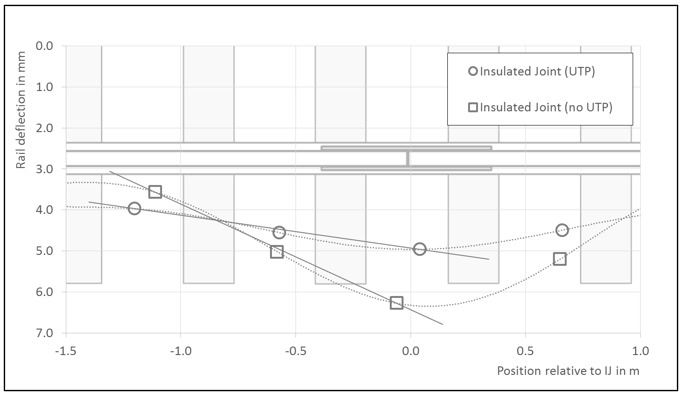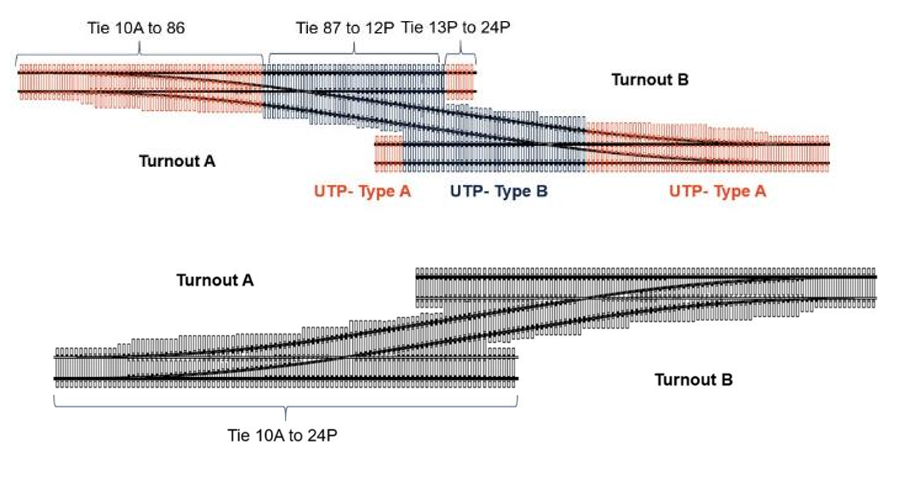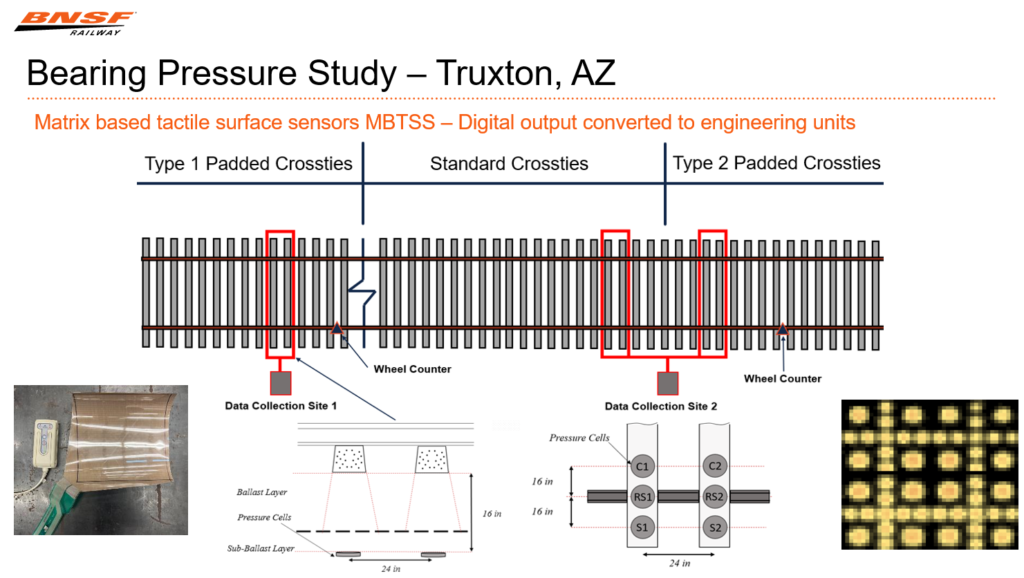Under-Tie Pads: Resilient Materials Make an Impact
by Jeff Tuzik
Areas of track that are subject to high impacts and dynamic loadings, such as turnouts, diamond crossings and other special trackwork, bridges and bridge approaches, high-degree curves, and highway/rail grade crossings are challenging to manage. Maintenance requires attention, resources, and significant ongoing investment. With more than 30,000 turnouts, 25,000 grade crossings, and 13,000 bridges on its system, Burlington Northern Santa Fe (BNSF) is always on the lookout for ways to improve performance and extend maintenance cycles and life-cycle costs of track and components in high-impact and high-wear applications. One of the more recent ways in which the railroad has done so is the use of resilient material pads to mediate forces transmitted through the track to the ballast and substructure. The effectiveness of pads in specific areas has led BNSF to explore their use more broadly, in a range of applications.
Like many railroads, BNSF has made significant investments in optimizing its special trackwork — investments that include implementation of a tapered universal heel, conformal castings with heavy points, lift frogs and jump frogs, movable-point frogs, improved rail steels, friction management, radiused guard rails, full flange-bearing diamonds, higher-speed OWLS (one-way low-speed) diamond crossings, vertical switches, and ramped frog castings. A long list, but there is always room for further optimization.
More recently, BNSF has also begun to use under-tie pads (UTPs) and ballast mats. “We’re doing large-scale tests now, trying different pads and different materials. It’s a big undertaking,” Erik Frohberg, Director of Track Standards and Procedures at BNSF told delegates at the 2023 Wheel/Rail Interaction conference. These pads, which are typically polyurethane elastomer or rubber-based, provide a number of benefits. One of their primary functions is to increase the contact area between tie and ballast; a standard tie on ballast has a contact area of about 3% to 5%, while a tie with a UTP has a contact area of about 35%, Frohberg said. As a result, stresses are better distributed, leading to less wear on the tie, less ballast degradation, and lower vertical track settlement rates. UTPs also help mitigate vehicle/track-induced noise and vibration, which, while not historically a top priority for North American freight railroads, is becoming increasingly relevant, he added.
UTPs and other pads have been applied in a variety of track conditions to achieve beneficial effects, such as improved lateral track resistance. A UTP in open (ballasted) track, for example, has been shown to mediate the forces transmitted into the ballast by improving contact between the ties and ballast. Concrete ties with UTPs, for example, provide better lateral resistance than timber or standard concrete ties.
UTPs installed in transition zones at bridges and tunnels help to better distribute forces associated with changes in track modulus. Pads are particularly effective in special trackwork, which is where BNSF first began their testing and implementation.
“It’s often said that diamonds are the single most demanding piece of trackwork on the railroad,” Frohberg said. For this reason, BNSF’s first resilient materials field study explored various applications at a high-traffic diamond in Sand Point, Idaho. This study assessed the effectiveness of multiple pads, (based on peak accelerations/impacts) including a casting pad, and bearing plate pad, and an under-tie pad. “Our first discovery was that it’s possible to have too many pads,” Frohberg said. The combination of all three pads resulted in too much track movement, high impacts, and, as a result, broken bolts and tie clips. The results of this study led BNSF to adopt a two-pad standard for diamonds: a leveling bearing plate pad to ease the transition, and an under-tie-pad to damp vibrations. “This combination gave us a roughly 40% decrease in impact forces at the diamond,” Frohberg said.
Insulated joints are another demanding piece of trackwork that can benefit from the application of resilient materials like UTPs. One BNSF study specifically explored the relationship between UTPs, concrete ties, and insulated joints. The key takeaway from this study is that insulated joints with UTPs experience lower impact forces and less deflection over time than their non-UTP counterparts. While it may seem counterintuitive that a joint on concrete ties with a resilient UTP would deform less that one without a pad, BNSF found that UTPs reduce ballast movement, which helps prevent a deflection feedback loop that causes ballast to shift, which leads to a higher propensity for deflection, Frohberg said. As in the case of diamonds, BNSF has adopted this UTP setup as a standard for insulated joints in new construction.
Bridges are another area in which BNSF has turned to resilient materials. Due to their relatively stiff modulus, bridges and bridge approaches present unique challenges. Transition zones are typically subject to significant impact forces and, BNSF found, ballast tends to degrade rapidly when sandwiched between the concrete bridge deck and concrete ties. Informed by several long-term studies, the use of a ballast mat on bridges has become the standard for new construction (and some retrofitting) at BNSF.
Although the use of pads has become standard practice in some situations, BNSF, in partnership with the University of Illinois Rail Transportation and Engineering Center (RailTEC) is engaged in ongoing research into resilient materials. This research is primarily focused on UTP efficacy in turnouts and open track. “In Europe [railroads] often prescribe a specific pad modulus for each individual pad throughout a turnout,” Frohberg said. BNSF aims to simplify that implementation by using just two different pad-types: a stiffer type at the frog and crossover, and a more flexible type in the rest of the body of the turnout. Ongoing monitoring at these sites yields data on:
- Vertical track deflection and transient displacement amplitudes
- Frog casting accelerations/wheel impacts
- Track settlement and rate of ballast compaction and consolidation
- Track geometry deviation
This data is also compared to non-UTP turnouts with an additional goal of determining the impact on turnout lifecycle cost.
Another study on the Emporia Subdivision on BNSF’s southern transcon is evaluating the effectiveness of UTPs in multiple applications, including bridges, curves, and grade crossings. The metrics under scrutiny at this site include:
- Absolute and differential settlement at bridge transitions
- Crosstie performance and support condition via crosstie bending test
- Single-tie lateral resistance via push test
- Curve shifting
- Track geometry deviation
The primary metrics being monitored are:
- Level survey at bridge abutments to determine absolute and differential settlement at bridge transitions
- Crosstie bending tests to assess crosstie performance / support condition
- Single-tie push tests to measure lateral resistance
- Curve staking to monitor curve breathing
- Geometry car data to assess track geometry degradation rates
“We’re also interested in how the use of UTPs affects tamping cycles,” Frohberg said, “an increase in MGT between [tamping] cycles could be an important part of the overall lifecycle cost.”
Finally, BNSF is also conducting a study of bearing pressure in open track to quantify the effect of various UTP types on substructure bearing pressures in a revenue service environment. Instrumentation including vertical wheel load circuits and pressure cells are being used to compare the distribution of vertical wheel loads under ties with two different UTPs and non-padded control ties.
These sites are already generating useful data, but Frohberg stressed that more data is necessary to be able to make a solid business-case for further implementation of UTPs. “We have to be very confident in our data to make changes in our track standards, but the data we have so far is promising,” he said.
Because there are currently no AREMA guidelines regarding resilient materials/pads, railroads are in a position in which they’re presented with many products, options, and applications, but are generally on their own when it comes to evaluating the use-cases and efficacy of the products. “It’s a bit of a wild-west situation,” Frohberg said. However, as more railroads and researchers conduct comprehensive studies like those that BNSF has undertaken, better guidance and best-practices will emerge and spread through the industry.

Jeff Tuzik is Managing Editor of Interface Journal.
This article is based on a presentation made at WRI 2023.




